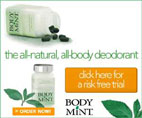
|
|
 |

 |
|

|
|
|
|
|
If you are wondering who exactly needs sunscreen, in a word; everyone! Yes, everyone should wear sunscreen everyday that they are exposed to the sun for more than 20 minutes at a time. The American Academy of Dermatology suggests that, regardless of skin type, a broad-spectrum sunscreen with an SPF of at least 15 should be used year-round. SPF stands for Sun Protection Factor. Sunscreens are rated by the strength of their SPF. The numbers can range from 2 to 50. The number reflects the products ability to block out the sun’s burning rays. However, the higher number does not increase the sunscreen’s protection proportionately. For Example SPF 15 means a 93 percent absorption of the sun burning rays, while SPF 30 will absorb 97 percent. SPF is calculated by comparing the amount of time it takes to create a sunburn on skin with sunscreen against skin without it. So, someone with fair skin that burns in ten minutes, would take 15 times longer to burn with a SPF 15 sunscreen, approximately 150 minutes. When choosing a sunscreen it is important to make sure that along with a SPF of 15 or higher that it is also has broad-spectrum protection. The Sun’s light contains both UVA and UVB rays. The UVB rays are the sun’s burning rays and are the primary cause of sunburn and skin cancer. UVA rays penetrate deeper into the dermis, or base layer of the skin. UVA rays also contribute to sunburns and skin cancer, which is why you want the broad-spectrum coverage. Ingredients like benzophenones, oxybenzone, sulisobenzone, titanium dioxide, zinc oxide, and avobenzone (Parsol 1789), extend the coverage beyond the UVB range and into the UVA range, helping to make sunscreens broad-spectrum. You may also want to get a sunscreen that is water resistant, especially if you are exercising or going to be in the water. The facts about skin cancer are overwhelming. Skin cancer is the most common form of cancer in the United States, with more than 1 million new cases diagnosed every year. Previous studies have confirmed that sun exposure is responsible for the development of at least two-thirds of all melanomas, which will be diagnosed in an estimated 51,400 people this year. One person dies of melanoma every hour. Melanoma is more common than any non-skin cancer among women between 25 and 29 years old. The FDA requires that all sunscreens be stable and at their original strength for at least three years, however if you are using sunscreen properly, a bottle shouldn’t last very long. It takes about 1 ounce of sunscreen to cover the average body. Some people have a concern that if they use sunscreen that they will be blocking the bodies ability to produce Vitamin D. To ensure you are getting the proper amounts of Vitamin D you can take a multi-vitamin or drink a glass of Vitamin D fortified milk. “While most people know that the sun’s rays are dangerous, that does not always translate into recognizable protective actions," said dermatologist Timothy M. Johnson, MD, chair of the AAD’s Melanoma/Skin Cancer Committee and Associate Professor, Department of Dermatology, University of Michigan. "Wearing sunscreen and practicing sun safe behavior can protect against not only sunburn, but premature aging and the future development of skin cancer." Sunscreens should be applied to dry skin 15-30 minutes BEFORE going outdoors. Don’t forget that lips get sunburned too, so cover them with a SPF 15 or higher as well. Some lip balms contain sunscreen or you can use a sunscreen made for lips and face. Sunscreens should be re-applied every 2 hours or after swimming or perspiring heavily. Even water resistant sunscreens may lose their effectiveness after 80 minutes in the water. Don’t forget that sun exposure occurs all the time even on a cloudy day. |
| This article is not a substitute for medical advice or treatment for any medical conditions. You should promptly seek professional medical advice if you have any concern about your health or physical condition, and you should always consult your physician before following the recommendations presented here. |
For more "Health & Wellness" click here to view back issues.
| |
||
|
©
Melt Magazine 2004
|
||